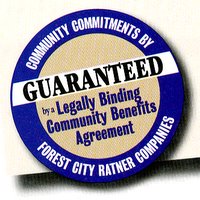Columbia University's controversial West Harlem expansion plan has spawned a Community Benefits Agreement (CBA) process, and, according to a report in City Limits, it diverges significantly from the Atlantic Yards CBA.
For one thing, the president of the new West Harlem Local Development Corporation is Patricia Jones, who is a vice-chair of Community Board 9, as well as the chair of CB 9’s 197-a Plan Committee and co-chair of the Manhattanville Rezoning Task Force. And the new LDC has 19 members representing area tenants, businesses, elected officials and CB9, as well as environmental, cultural and faith-based organizations.
Contrast with AY
 That contrasts with the eight organizations, most of them fledgling, that signed the Atlantic Yards CBA. City Limits quotes Brad Lander of the Pratt Center for Community Development:
That contrasts with the eight organizations, most of them fledgling, that signed the Atlantic Yards CBA. City Limits quotes Brad Lander of the Pratt Center for Community Development:
Lander faulted the agreements signed by Bronx Borough President Adolfo Carrion for the Bronx Terminal Market and new Yankee stadium for lacking a grassroots component. And not enough community stakeholders participated in negotiating the benefits agreement with developer Bruce Ratner over his proposed Atlantic Yards development, he said.
The city seems to be learning that community groups in such negotiations need some juice. City Limits reports:
City officials have encouraged the dialogue. The New York City Economic Development Corporation provided $350,000 and a professional mediator, John Bickerman, to facilitate negotiations. There is no formal place in current review processes for a community benefits agreement, and Mayor Bloomberg has not consistently supported such agreements.
There was no such formal and financial backing for the Atlantic Yards CBA. Indeed, the city is continuing to rethink the CBA concept. So much for the model that supporters proclaim.
For one thing, the president of the new West Harlem Local Development Corporation is Patricia Jones, who is a vice-chair of Community Board 9, as well as the chair of CB 9’s 197-a Plan Committee and co-chair of the Manhattanville Rezoning Task Force. And the new LDC has 19 members representing area tenants, businesses, elected officials and CB9, as well as environmental, cultural and faith-based organizations.
Contrast with AY
 That contrasts with the eight organizations, most of them fledgling, that signed the Atlantic Yards CBA. City Limits quotes Brad Lander of the Pratt Center for Community Development:
That contrasts with the eight organizations, most of them fledgling, that signed the Atlantic Yards CBA. City Limits quotes Brad Lander of the Pratt Center for Community Development:Lander faulted the agreements signed by Bronx Borough President Adolfo Carrion for the Bronx Terminal Market and new Yankee stadium for lacking a grassroots component. And not enough community stakeholders participated in negotiating the benefits agreement with developer Bruce Ratner over his proposed Atlantic Yards development, he said.
The city seems to be learning that community groups in such negotiations need some juice. City Limits reports:
City officials have encouraged the dialogue. The New York City Economic Development Corporation provided $350,000 and a professional mediator, John Bickerman, to facilitate negotiations. There is no formal place in current review processes for a community benefits agreement, and Mayor Bloomberg has not consistently supported such agreements.
There was no such formal and financial backing for the Atlantic Yards CBA. Indeed, the city is continuing to rethink the CBA concept. So much for the model that supporters proclaim.
Comments
Post a Comment